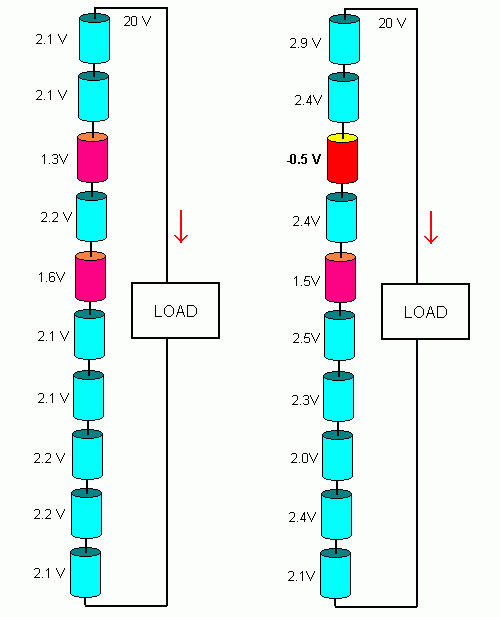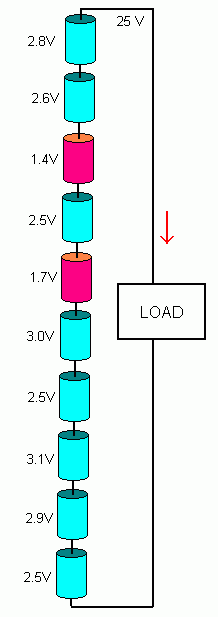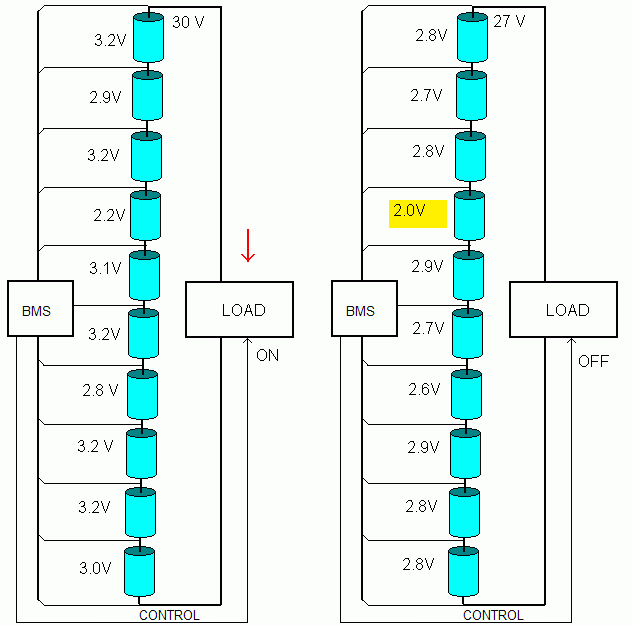 Li-Ion BMS
Li-Ion BMS
|
Home White Paper - Low voltage cut-off: a false sense of security Without a BMS, even with a low voltage cutoff, cells in an high voltage battery pack will be over-discharged 
Whether a cell can stand being fully discharged depends on its chemistry:
No cell can stand being reverse charged, regardless of its chemistry. In theory, if the pack starts perfectly balanced when full, all the cells will discharge evenly, and all their voltages will remain in lockstep, all the way down to discharged. In reality, the capacity of the cells will be mismatched, and the least capacity cells will reach the low voltage first. (Unless cells were pre-selected and matched to have exactly the same capacity.) A battery with 10 LiFePO4 cells in series (whose minimum safe voltage is 2.0 V) may very well have a total voltage of 20 V. But there's no telling if some cells may be at 3.0 V, while others at 1.5 V. LiIon cells do not deal well with over-discharging; once discharged, they cannot produce more current as the other cells in series are still doing so. Their voltage drops rapidly once discharged, so it's very easy to bring their voltage to below 2.0 V, or even reverse them. 
Overdischarging a high voltage battery: the most discharged cell is under-voltage (left) or even reversed! (right) Various battery loads handle low battery voltage differently:
Even a load with a low voltage cut-off cannot prevent this problem: the total battery voltage may very well be above the cut-off point, yet an individual cell may be over discharged. You may feel comfortable using a 10-cell LiFePO4 pack with a motor drive with a low-voltage cut-off of 25 V, a full 5 V above the 20 V minimum. But, in reality, you may be damaging the most discharged cells and not know it! 
Discharging with a low voltage cut-off load: the most discharged cells are below 2.0V!
This is why a BMS (Battery Management System) is essential when discharging high voltage LiIon packs.
Not only will the BMS tell you if a cell's voltage is too low.
When properly connected to the load, as soon as any cell reaches its minimum discharged voltage, the BMS will turn off the load. 
Discharging with just a BMS controlling the load (left). Discharging stops (right) when the least charged cell reaches its minimum voltage, even if the total pack voltage may still be above the low-voltage cut-off of the load. In particular, in a vehicle, the BMS may gradually tell motor driver to the reduce the available drive, enabling the user to still get home. An advantage of using a BMS is that a programmable low voltage cut-off is not required: any load will do, even a resistive one, as long as the BMS can turn it on and off.
Davide Andrea, Elithion, 1/8/09 | ||
© 2008~2025 Davide Andrea. All rights reserved, except where noted by CC mark. Page published on Aug 01 2009. Graphic design by morninglori